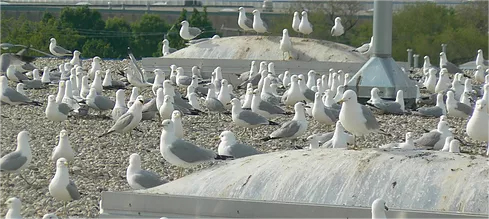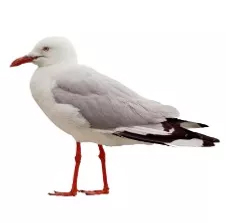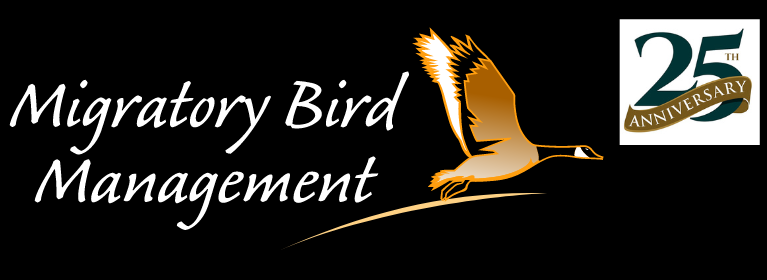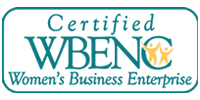

APPEARANCE:
Ring billed are smaller gulls, distinguished by yellow-green legs and a black band around their yellow bill. They are also more commonly seen inland. Herring gulls are much larger, with pink feet and robust bodies. They have a red spot near the tip of their lower bill. Both species have grey back and grey wings with black tips.
BEHAVIOR:
Sociable. Herring gulls spend time along shorelines, picking food off the surface of the water. Ring billed gulls stay inland, often near freshwater, and will circle looking for food as well as forage both afloat and on foot.
DIET:
Omnivorous, varying with location and season. Prefers fish and insects, and worms, grain, rodents, and refuse. Ring billed will also forage in freshly plowed fields. Herring gulls near the ocean will feed on schools of fish near the surface, as well as scavenge refuse and carrion.
HABITAT:
Lakes, bays, coasts, piers, dumps, plowed fields. Likes water in all seasons but will eat on land. Common around human altered habitats.
NESTING:
Breeds in colonies, nests made on the ground near water in an area with sparse plant growth. Nests for ring billed gulls will have 2-4 eggs typically, unless a female pair share nest. Herring gulls will usually have 3, sometimes less but very rarely 4.
MIGRATION:
Ring-billed will migrate in flocks, following coastlines or major river systems. Moves farther south in winter. Herring are present year-round as far north as the great lakes, southern Alaska, and New England. Younger birds will migrate further south than older birds in winter.
ISSUES CAUSED BY GULLS:
High populations negatively impact beaches, properties with bodies of water, and industrial/retail/office buildings:
- Affect populations of nesting terns and other native birds at beaches
- Damage agricultural crops
- Threaten safety at airports
- Transmit disease
- Nuisance when resting on the large flat rooftops of buildings
- Droppings can accumulate below ledges, railings, etc. that they perch on and cause damage
HOW TO MANAGE ISSUES WITH GULLS:
Exclude gulls from preferred nesting places
- Porcupine wires, bird wire, netting, parallel steel wire, nylon monofilament line etc. Habitat modification
- Keep human garbage sites cleaner (landfills, fish docks, food processing plants, livestock feedlots etc.) Limit mowing grass in airports, parks etc. so long grass discourages flocks Frighten gulls
- Trained dogs, exploders, distress calls, birds of prey, radio controlled small aircraft, chemical repellents Trapping or killing, requiring permits Removing/sterilizing eggs
Sources: The Audubon Society, Cornell Lab of Ornithology bird guide, Humane Society of the United States, Internet Center for Wildlife Damage Management


